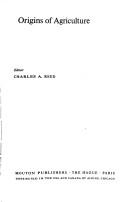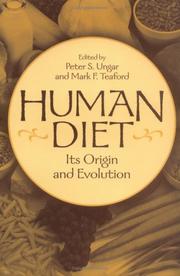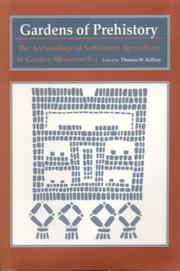| Listing 1 - 10 of 31 | << page >> |
Sort by
|
Book
ISBN: 9781739730192 Year: 2022 Publisher: [Place of publication not identified] : Council for British Research in the Levant (CBRL),
Abstract | Keywords | Export | Availability | Bookmark
 Loading...
Loading...Choose an application
- Reference Manager
- EndNote
- RefWorks (Direct export to RefWorks)
Agriculture, Prehistoric. --- Prehistoric agriculture --- Prehistoric peoples --- Agriculture --- Food
Book
ISBN: 9781789251418 9781789251401 9781789251425 9781789251432 1789251419 1789251435 1789251400 Year: 2020 Publisher: Oxford
Abstract | Keywords | Export | Availability | Bookmark
 Loading...
Loading...Choose an application
- Reference Manager
- EndNote
- RefWorks (Direct export to RefWorks)
All farming in prehistoric Europe ultimately came from elsewhere in one way or another, unlike the growing numbers of primary centers of domestication and agricultural origins worldwide. This fact affects every aspect of our understanding of the start of farming on the continent because it means that ultimately, domesticated plants and animals came from somewhere else, and from someone else. In an area as vast as Europe, the process by which food production becomes the predominant subsistence strategy is of course highly variable, but in a sense the outcome is the same, and has the potential for addressing more large-scale questions regarding agricultural origins. Therefore, a detailed understanding of all aspects of farming in its absolute earliest form in various regions of Europe can potentially provide a new perspective on the mechanisms by which this monumental change comes to human societies and regions.
E-books --- Agriculture, Prehistoric --- Neolithic period --- Agriculture, Prehistoric. --- Prehistoric agriculture --- Prehistoric peoples --- Agriculture --- Food --- Agriculture, Prehistoric - Europe --- Neolithic period - Europe --- Europe.

ISBN: 131541760X 1315417618 1598747444 9781598747447 1598749889 9781598749885 Year: 2007 Publisher: Walnut Creek, CA : [London] : Left Coast Press ; University College London Institute of Archaeology Publications,
Abstract | Keywords | Export | Availability | Bookmark
 Loading...
Loading...Choose an application
- Reference Manager
- EndNote
- RefWorks (Direct export to RefWorks)
In this major new volume, leading scholars demonstrate the importance of archaeobotanical evidence in the understanding of the spread of agriculture in southwest Asia and Europe. Whereas previous overviews have focused either on Europe or on southwest Asia, this volume considers the transition from a pan-regional perspective, thus making a significant contribution to our understanding of the processes and dynamics in the transition to food production on both continents. It will be relevant to students, researchers, practitioners and instructors in archaeology, archaeobotany, agrobotany,
Agriculture, Prehistoric --- Agriculture --- Plants, Cultivated --- Origin of cultivated plants --- Cultivated plants --- Domestication --- Plant introduction --- Plants, Useful --- Origin of agriculture --- Prehistoric agriculture --- Prehistoric peoples --- Origin. --- History --- Food
Book
ISBN: 1282292595 9786612292590 1402098405 Year: 2009 Publisher: Dordrecht ; New York : Springer,
Abstract | Keywords | Export | Availability | Bookmark
 Loading...
Loading...Choose an application
- Reference Manager
- EndNote
- RefWorks (Direct export to RefWorks)
This book deals with the early history of agriculture in a defined part of Western Europe: the loess belt west of the river Rhine. It is a well-illustrated book that integrates existing and new information, starting with the first farmers and ending when food production was no longer the chief source of livelihood for the entire population. The loess belt was chosen because it is a region with only one type of soil and climate as these are all-important factors where farming is concerned. Subjects covered are crops, crop cultivation, livestock and livestock handling, the farm and its yard, and the farm in connection with other farms. Crop plants and animals are described, together with their origin. New tools such as the plough, wheen, wagon and scythe are introduced. Groundplans of farm buildings, the history of the outhouse and the presence or absence of hamlets are presented as well, and the impact of farming on the landscape is not forgotten. The loess belt was not an island and the world beyond its boundaries was important for new ideas, new materials and new people. Summarising six millennia of agriculture, the thinking in terms of the Western European loess belt as one agricultural-cultural unit seems justified. Audience: This book will be of interest to researchers in archaeology, history and agriculture, and to landscape engineers. .
Agriculture, Prehistoric --- Landscape archaeology --- Archaeology --- Cultural landscapes --- Prehistoric agriculture --- Prehistoric peoples --- Agriculture --- Food --- Archaeology. --- History. --- Agriculture. --- Geography. --- History, general. --- Geography, general. --- Cosmography --- Earth sciences --- World history --- Farming --- Husbandry --- Industrial arts --- Life sciences --- Food supply --- Land use, Rural --- Annals --- Auxiliary sciences of history --- Archeology --- Anthropology --- History --- Antiquities
Book

ISBN: 1760461164 1760461156 9781760461164 9781760461157 Year: 2017 Publisher: Acton, A.C.T. ANU Press
Abstract | Keywords | Export | Availability | Bookmark
 Loading...
Loading...Choose an application
- Reference Manager
- EndNote
- RefWorks (Direct export to RefWorks)
Kuk is a settlement at c. 1600 m altitude in the upper Wahgi Valley of the Western Highlands Province of Papua New Guinea, near Mount Hagen, the provincial capital. The site forms part of the highland spine that runs for more than 2500 km from the western head of the island of New Guinea to the end of its eastern tail. Until the early 1930s, when the region was first explored by European outsiders, it was thought to be a single, uninhabited mountain chain. Instead, it was found to be a complex area of valleys and basins inhabited by large populations of people and pigs, supported by the intensive cultivation of the tropical American sweet potato on the slopes above swampy valley bottoms. With the end of World War II, the area, with others, became a focus for the development of coffee and tea plantations, of which the establishment of Kuk Research Station was a result. Large-scale drainage of the swamps produced abundant evidence in the form of stone axes and preserved wooden digging sticks and spades for their past use in cultivation. Investigations in 1966 at a tea plantation in the upper Wahgi Valley by a small team from The Australian National University yielded a date of over 2000 years ago for a wooden stick collected from the bottom of a prehistoric ditch. The establishment of Kuk Research Station a few kilometres away shortly afterwards provided an ideal opportunity for a research project.
Agriculture, Prehistoric --- Anthropology --- Water-saturated sites (Archaeology) --- Sites, Water-saturated (Archaeology) --- Waterlogged sites (Archaeology) --- Wet sites (Archaeology) --- Wetland archaeology --- Wetland sites (Archaeology) --- Wetlands archaeology --- Prehistoric agriculture --- Prehistoric peoples --- Agriculture --- Excavations (Archaeology) --- Human beings --- Food --- Western Highlands Province (Papua New Guinea) --- Antiquities. --- West Highlands Province (Papua New Guinea) --- Primitive societies --- Social sciences

ISBN: 9027979197 0202900436 9780202900438 9789027979193 3111751473 3110813483 9783110813487 Year: 1977 Publisher: The Hague Mouton
Abstract | Keywords | Export | Availability | Bookmark
 Loading...
Loading...Choose an application
- Reference Manager
- EndNote
- RefWorks (Direct export to RefWorks)
Agriculture --- Agriculture préhistorique --- Agriculture traditionnelle --- Agriculture, Prehistoric --- Agriculture, Prehistoric. --- Prehistoric peoples --- Prehistoric peoples. --- Congrès. --- Origin --- Congresses. --- Origin. --- Origines --- 63 <09> --- 63 --- 93 --- 631.9 --- 572 --- 39 --- 902 --- 903 --- (3) --- 63 <09> History of agriculture --- History of agriculture --- Prehistoric agriculture --- Farming --- Husbandry --- Industrial arts --- Life sciences --- Food supply --- Land use, Rural --- Congresses --- Origin&delete& --- Food --- Agriculture - Congresses --- Agriculture primitive --- Histoire

ISBN: 0897897366 0313011397 9780313011399 1280908408 9781280908408 9780897897365 9786610908400 6610908400 9798400667206 Year: 2002 Publisher: Westport, Conn. Bergin & Garvey
Abstract | Keywords | Export | Availability | Bookmark
 Loading...
Loading...Choose an application
- Reference Manager
- EndNote
- RefWorks (Direct export to RefWorks)
Prehistoric peoples --- Hunting, Prehistoric. --- Agriculture, Prehistoric. --- Hunting and gathering societies. --- Diet --- Homme préhistorique --- Chasse préhistorique --- Agriculture préhistorique --- Chasseurs-cueilleurs --- Alimentation --- Food. --- History. --- Histoire --- Health --- Food --- Food habits --- Nutrition --- Food gathering societies --- Gathering and hunting societies --- Hunter-gatherers --- Hunting, Primitive --- Ethnology --- Subsistence hunting --- Prehistoric agriculture --- Hunting and foraging, Prehistoric --- Hunting and gathering, Prehistoric --- Prehistoric hunting --- Agriculture, Prehistoric --- Agriculture --- Primitive societies

ISBN: 081738376X 0585140936 9780585140933 9780817305659 0817305653 9780817383763 0817305653 Year: 1992 Publisher: Tuscaloosa, Ala. University of Alabama Press
Abstract | Keywords | Export | Availability | Bookmark
 Loading...
Loading...Choose an application
- Reference Manager
- EndNote
- RefWorks (Direct export to RefWorks)
The prehistoric agricultural systems of the New World provided the foundations for a diverse set of complex social developments ranging from the puebloan societies of the American Southwest to the archaic state polities of Mesoamerica and the Andean region. From the tropical forests of Central America to the arid environments or northern New Mexico, Native American farmers made use of a distinctive set of cultigens and cropping systems that supported-with varying degrees of success-growing populations and expanding economies. Lacking most domesticated animals, so important to the mi
Indians --- Land settlement patterns, Prehistoric --- Agriculture, Prehistoric --- Prehistoric land settlement patterns --- Prehistoric agriculture --- Prehistoric peoples --- Aborigines, American --- American aborigines --- American Indians --- Amerindians --- Amerinds --- Pre-Columbian Indians --- Precolumbian Indians --- Ethnology --- Indigenous peoples --- Antiquities --- Congresses. --- Agriculture --- Food --- Civilization --- America --- Americas --- New World --- Western Hemisphere
Book
ISBN: 1785702483 9781785702488 9781785702501 1785702505 9781785702495 1785702491 9781785702471 1785702475 Year: 2016 Publisher: Oxford
Abstract | Keywords | Export | Availability | Bookmark
 Loading...
Loading...Choose an application
- Reference Manager
- EndNote
- RefWorks (Direct export to RefWorks)
The types of relationship studied include the importance of manure to farming societies, dogs as livestock guardians, seasonality in pastoralist societies, butchery, symbolism and food. Examples are drawn from the Pleistocene to the present day and from the Altai Mountains, Ethiopia, Iraq, Italy, Mongolia and North America. The 11 papers work from the basis that animals are an integral part of society and that past society is the object of most archaeological inquiry. Discussion papers explore this topic and use the case-studies presented in other contributions to suggest the importance of ethnozooarchaeology not just to archaeology but also to anthrozoology.
Ethnoarchaeology. --- Animal remains (Archaeology) --- Human-animal relationships --- Agriculture, Prehistoric. --- Livestock --- Animal husbandry --- Farm animals --- Live stock --- Stock (Animals) --- Stock and stock-breeding --- Agriculture --- Animal culture --- Animal industry --- Domestic animals --- Food animals --- Herders --- Range management --- Rangelands --- Prehistoric agriculture --- Prehistoric peoples --- Archaeozoology --- Zooarchaeology --- Zoology in archaeology --- Archaeology --- Bones --- Animal paleopathology --- Ethnic archaeology --- Ethnicity in archaeology --- Ethnology in archaeology --- Ethnology --- Social archaeology --- History. --- Food --- Methodology

ISBN: 1134282567 1280150793 0203023714 9780203023716 9780415345507 0415345502 9780415345514 0415345510 9786610150793 6610150796 0203567048 9780203567043 0415345510 0415345502 0415235510 9781134282562 9781280150791 9781134282517 9781134282555 1134282559 Year: 2005 Publisher: London Routledge
Abstract | Keywords | Export | Availability | Bookmark
 Loading...
Loading...Choose an application
- Reference Manager
- EndNote
- RefWorks (Direct export to RefWorks)
This fascinating study explores how our prehistoric ancestors developed rituals from everyday life and domestic activities. This book examines farming, craft production and the occupation of houses, which were all ritualized in prehistoric Europe.
Rites and ceremonies, Prehistoric --- Architecture, Prehistoric --- Agriculture, Prehistoric --- Tools, Prehistoric --- Human remains (Archaeology) --- Antiquities, Prehistoric --- Bioarchaeology --- Skeletal remains (Archaeology) --- Human skeleton --- Primate remains (Archaeology) --- Implements, Prehistoric --- Implements, utensils, etc., Prehistoric --- Prehistoric implements --- Prehistoric tools --- Prehistoric agriculture --- Prehistoric peoples --- Prehistoric architecture --- Prehistoric rites and ceremonies --- Agriculture --- Food --- Architecture, Primitive
| Listing 1 - 10 of 31 | << page >> |
Sort by
|

 Search
Search Feedback
Feedback About UniCat
About UniCat  Help
Help News
News